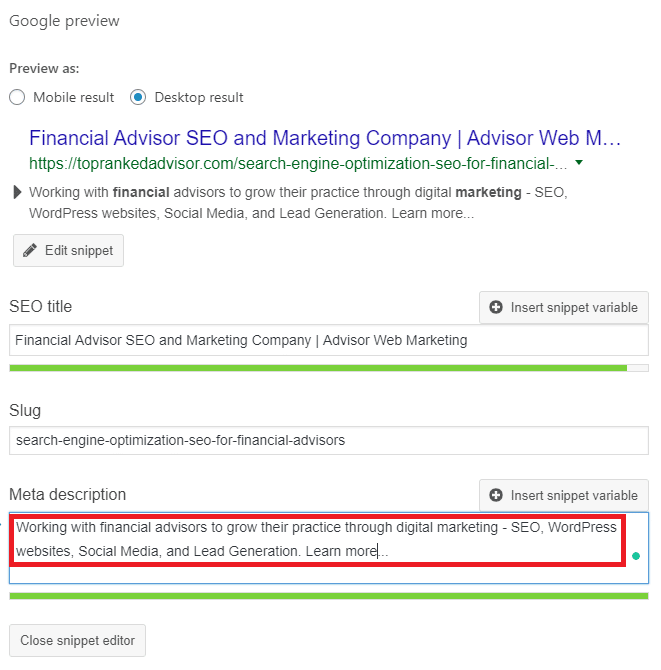The Meta Description tag (MDT) is an actual example of the near-mythical “low hanging fruit” that marketers are always writing about. It’s a quick, inexpensive change that can positively impact your search engine click-through rates (CTRs).
Read: The Ultimate Guide to SEO for Advisors in 2021
What is the Meta Description Tag?
The Meta Description tag is a statement describing the content of the webpage. It is not visible to website visitors (unless they know where to look) but is visible to search engines, and to those who find you on the Search Engine Results Pages (SERPs).
It usually makes up the content that appears on lines 3 – 5 (below your URL and title tag) of your listing on the SERPs, making it your first opportunity to “sell” to your potential visitor, meaning that it can directly impact your Click-through-rate (CTR) – definitely worth putting some thought and time into.
If you don’t create an MDT (and sometimes even when you do), Google will take a snippet of your content that it believes represents your firm, like the example below.
The above MDT doesn’t do a great job of convincing searchers to click on the listing. It’s rather generic, and you can see that Google used an ellipsis (…) to join 2 paragraphs together. The original content appeared on the site’s homepage.
To check the Meta Description Tags on your webpage (or on a competitor’s page):
From Firefox, Chrome, or Internet Explorer: hit Control U to see the Source Code.
The Meta Description code will look something like:
In the above section – which is not from the previous advisor site as it didn’t have any content for the description – the first part of it reads . . .
Meta Description Best Practices
1. Your Meta Description tag should be unique for every page, and should include your primary keyword or phrase for that page – that keyword will appear bold when it is used as part of the search term.
For example, a search for “Financial Planner Boise” resulted in the following search listing – notice that property management is bold which could help attract clicks:
2. Your Meta Description tag can be as long as you want, but Google will only display the first 155-160 characters (including spaces) on the Search Results Page – plan accordingly. You can see in the above search listing that the message is truncated. Remember, you’re primary goal is to provide value that earns clicks.
3. Apply copywriting best practices to your Meta Descriptions.
Which listing would you be more likely to click on:
or,
Okay, while it can probably still be improved upon and is dependent on your target audience, I think it’s safe to say that the second MDT is better than the original. The point is, don’t take your meta description tags for granted – put a little thought and creativity into them.
Not particularly creative? No worries . . . thankfully, it’s easy to find good examples of well-written meta descriptions.
Coming Up with Good Meta Description Tag Copy:
a. Study Pay Per Click Ads for that search phrase: Good Pay Per Click companies continuously test and refine their copy, keeping what works best and discarding those versions that don’t convert as well.
b. Study your competitor’s Organic meta descriptions (remember – Control U): Again, see what’s working for your competition and base your copy on those meta tags.
c. Remember to focus on benefits rather than features: “… are you concerned about outliving your retirement savings …?”
4. Always remember that you are writing for a potential customer. Your Meta Description Tag is a sales tool and should always be crafted as such – include a call-to-action when appropriate.
5. Google will cut off any quotations used in your Meta Description Tag. Moz recommends removing all non-alphanumeric characters if possible, but if you do use a quote, use single quotations rather than double.
If you leave your Meta Description tag empty, which is actually a fairly common occurrence, you’re leaving it up to Google to “sell” to the searcher, as above, it will choose content from your website to auto display as your meta description tag.
How to Change Your Meta Description Tag
If you’re using a Content Management System (CMS) (i.e. WordPress, Drupal, Hubspot), managing your Meta Descriptions is fairly straightforward – one of the many advantages of using a CMS.
Your CMS will provide a spot for you to change your Meta Description (it may just call it Description). In WordPress, I use the Yoast SEO plugin, which offers a “Meta Description” editing box below the page content.
If, on the other hand, your site does not have a CMS, the changes will have to be made to the actual code. Although changing the text within the code is not that difficult, accessing the code can be a challenge. If this is the case, it’s probably best to write your copy and hire a professional to input the changes.
Thanks for reading. As always, your comments and questions are both welcomed and appreciated.
Editor’s Note: This post was originally published in April of 2013, but has been updated for accuracy and comprehensiveness. The most recent update was 05/14/20.
Brent is the Principal and founder of Advisor Rankings - a specialized SEO and AI search optimization agency dedicated to helping independent financial advisors strengthen authority, boost traffic, and attract high-quality leads online. He holds an MBA in Financial Planning, giving him a strong foundation in the technical side of the profession. With more than a decade of experience specializing in SEO for advisors, Brent bridges financial knowledge with digital marketing expertise. He has presented at NAPFA, FinCon, and XYPN, and appeared on several industry podcasts, including the Financial Advisor Success Podcast with Michael Kitces.
- Brent Carnduffhttps://advisorrankings.io/author/brent/
- Brent Carnduffhttps://advisorrankings.io/author/brent/
- Brent Carnduffhttps://advisorrankings.io/author/brent/
- Brent Carnduffhttps://advisorrankings.io/author/brent/









